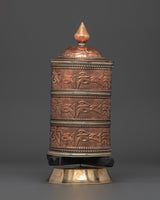
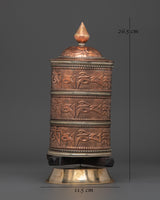
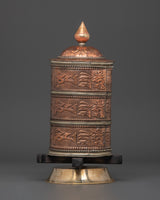
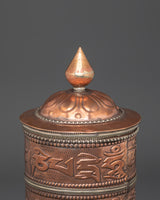
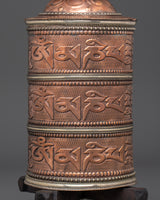
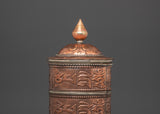
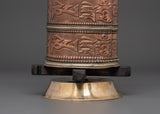
Tibetan Mantra Wheel | Meditation And Ritual Spinner

100% AUTHENTIC

HANDMADE

FREE SHIPPING
Traditional Tibetan Mantra Wheel for Meditation, Blessings, and Spiritual Healing
--------------------------------------------------------
Size: 26.5cm(Height) x 11.5cm(Width)
Weight: 0.55kg
Materials: Copper, Brass
--------------------------------------------------------
About our Prayer Wheel:
This Tibetan Mantra Wheel is a wonderfully created spiritual tool that will help you improve your meditation, mantra recitation, and energy healing practices. This prayer wheel, which stands 26.5cm tall and 11.5cm broad, is composed of copper and brass and has an attractive appearance. Weighing 0.55kg, it has a balanced feel when held, making it ideal for daily use or display on an altar. The mystical symbols and inscriptions on the wheel are intended to provide blessings and positive energy with each spin.
Spinning the Tibetan mantra wheel is a powerful exercise that purports to cleanse negative karma, align the mind, and send compassionate prayers into the universe. Practitioners have long used the wheel to chant mantras, with each turn representing the propagation of positive thoughts and benefits. Each spin of the wheel is claimed to increase the benefits of your mantras, providing spiritual purification and inviting blessings of peace, prosperity, and protection. This Tibetan prayer wheel is a must-have for individuals wishing to improve their spiritual practice. It can be used for chakra healing, spiritual ceremonies, or simply for attentive meditation.
Introduction to Prayer Wheel
A prayer wheel is cylindrical on a spindle and is used in Tibetan Buddhism. It is typically inscribed with the mantra "Om Mani Padme Hum" and rotated by hand as a form of spiritual practice and to accumulate merit. Spinning the wheel is believed to have the same spiritual benefits as verbally reciting the mantra. The use of prayer wheels is widespread in Tibetan Buddhism and has spread to other cultures.
How does the Buddhist Prayer Wheel benefit us?
The benefits associated with rotating the wheel are numerous. It promotes knowledge, compassion, and bodhicitta in the practitioner and improves siddhis (spiritual powers such as clairvoyance, precognition, etc.). The practitioner can repeat the mantra as often as possible while the wheel is rolling, maintaining a calm, meditative attitude. A Tibetan Buddhist tradition holds that after a practice session, one should dedicate any acquired merits to the benefit of all sentient beings. Then three times Om Ah Hum. This is usually among Tibetans after finishing any Buddhist practice, including the prayer wheel exercise.
How do you set up your own Buddhist Shrine?
• Find a clean, quiet, and uncluttered spot
• Set up an altar table and cover it with an altar cloth that calls to you
• Place your sacred item at the center

















